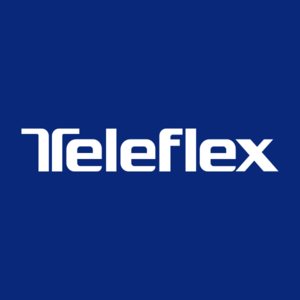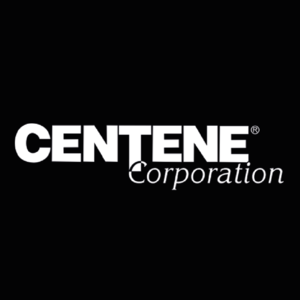
Centene (CNC)
We aren’t fans of Centene. Not only has its sales growth been weak but also its negative returns on capital show it destroyed value.― StockStory Analyst Team
1. News
2. Summary
Why Centene Is Not Exciting
Serving nearly 1 in 15 Americans through its government healthcare programs, Centene (NYSE:CNC) is a healthcare company that manages government-sponsored health insurance programs like Medicaid and Medicare for low-income and complex-needs populations.
- Performance over the past five years shows its incremental sales were much less profitable, as its earnings per share fell by 5.1% annually
- Negative returns on capital show management lost money while trying to expand the business, and its falling returns suggest its earlier profit pools are drying up
- On the bright side, its dominant market position is represented by its $185.9 billion in revenue, which gives it negotiating power over membership pricing and reimbursement rates


Centene’s quality is insufficient. We’re redirecting our focus to better businesses.
Why There Are Better Opportunities Than Centene
High Quality
Investable
Underperform
Why There Are Better Opportunities Than Centene
At $38.27 per share, Centene trades at 16x forward P/E. Yes, this valuation multiple is lower than that of other healthcare peers, but we’ll remind you that you often get what you pay for.
Cheap stocks can look like a great deal at first glance, but they can be value traps. They often have less earnings power, meaning there is more reliance on a re-rating to generate good returns - an unlikely scenario for low-quality companies.
3. Centene (CNC) Research Report: Q3 CY2025 Update
Health coverage company Centene (NYSE:CNC) reported Q3 CY2025 results topping the market’s revenue expectations, with sales up 18.2% year on year to $49.69 billion. Its non-GAAP profit of $0.50 per share was significantly above analysts’ consensus estimates.
Centene (CNC) Q3 CY2025 Highlights:
- Revenue: $49.69 billion vs analyst estimates of $47.92 billion (18.2% year-on-year growth, 3.7% beat)
- Adjusted EPS: $0.50 vs analyst estimates of -$0.16 (significant beat, figure includes a $0.10 benefit of a low adjusted effective tax rate in the quarter)
- Adjusted EPS guidance for the full year is $2 at the midpoint, beating analyst estimates by 19.6%
- Operating Margin: -14%, down from 1.6% in the same quarter last year
- Free Cash Flow was $1.15 billion, up from -$1.13 billion in the same quarter last year
- Customers: 27.97 million, down from 28 million in the previous quarter
- Market Capitalization: $16.3 billion
Company Overview
Serving nearly 1 in 15 Americans through its government healthcare programs, Centene (NYSE:CNC) is a healthcare company that manages government-sponsored health insurance programs like Medicaid and Medicare for low-income and complex-needs populations.
Centene operates through four main segments: Medicaid, Medicare, Commercial, and Other. As the largest Medicaid insurer in the country, Centene serves over 14 million Medicaid recipients across 30 states, providing coverage for various populations including low-income families, individuals with disabilities, and children. The company also serves 1.3 million Medicare Advantage members and 4.6 million Medicare Part D prescription drug plan members.
In the commercial space, Centene has established itself as the largest Health Insurance Marketplace carrier under its Ambetter Health brand, serving 3.9 million members across 28 states. These marketplace plans provide subsidized coverage options for individuals without access to employer-sponsored insurance.
The company's business model revolves around contracting with federal and state governments to provide managed care services. When a state Medicaid agency or the federal Medicare program pays Centene a fixed monthly premium per member, the company then works to coordinate care efficiently through its provider networks. A typical Centene member might visit a primary care physician in the company's network for preventive care, with Centene covering the cost while also providing care management services to ensure appropriate utilization.
Centene's approach emphasizes local delivery of healthcare services, with teams embedded in the communities they serve. This local focus allows the company to build relationships with community providers and tailor programs to specific population needs. For example, a Centene care manager might coordinate services for a dual-eligible Medicare-Medicaid member who requires both medical care and long-term support services.
Beyond insurance administration, Centene offers specialty services including pharmacy benefit management through AcariaHealth, behavioral health services through Magellan Health, and vision and dental benefits through Envolve Benefit Options. The company also operates clinical healthcare services in certain markets, providing direct patient care through community medical groups.
4. Health Insurance Providers
Upfront premiums collected by health insurers lead to reliable revenue, but profitability ultimately depends on accurate risk assessments and the ability to control medical costs. Health insurers are also highly sensitive to regulatory changes and economic conditions such as unemployment. Going forward, the industry faces tailwinds from an aging population, increasing demand for personalized healthcare services, and advancements in data analytics to improve cost management. However, continued regulatory scrutiny on pricing practices, the potential for government-led reforms such as expanded public healthcare options, and inflation in medical costs could add volatility to margins. One big debate among investors is the long-term impact of AI and whether it will help underwriting, fraud detection, and claims processing or whether it may wade into ethical grey areas like reinforcing biases and widening disparities in medical care.
Centene's main competitors in the government-sponsored healthcare space include UnitedHealth Group's (NYSE: UNH) Optum division, Elevance Health (NYSE: ELV) formerly known as Anthem, Humana (NYSE: HUM), Molina Healthcare (NYSE: MOH), and CVS Health's (NYSE: CVS) Aetna division.
5. Economies of Scale
Larger companies benefit from economies of scale, where fixed costs like infrastructure, technology, and administration are spread over a higher volume of goods or services, reducing the cost per unit. Scale can also lead to bargaining power with suppliers, greater brand recognition, and more investment firepower. A virtuous cycle can ensue if a scaled company plays its cards right.
With $185.9 billion in revenue over the past 12 months, Centene is one of the most scaled enterprises in healthcare. This is particularly important because health insurance providers companies are volume-driven businesses due to their low margins.
6. Revenue Growth
A company’s long-term sales performance is one signal of its overall quality. Any business can have short-term success, but a top-tier one grows for years. Thankfully, Centene’s 12.8% annualized revenue growth over the last five years was solid. Its growth beat the average healthcare company and shows its offerings resonate with customers, a helpful starting point for our analysis.
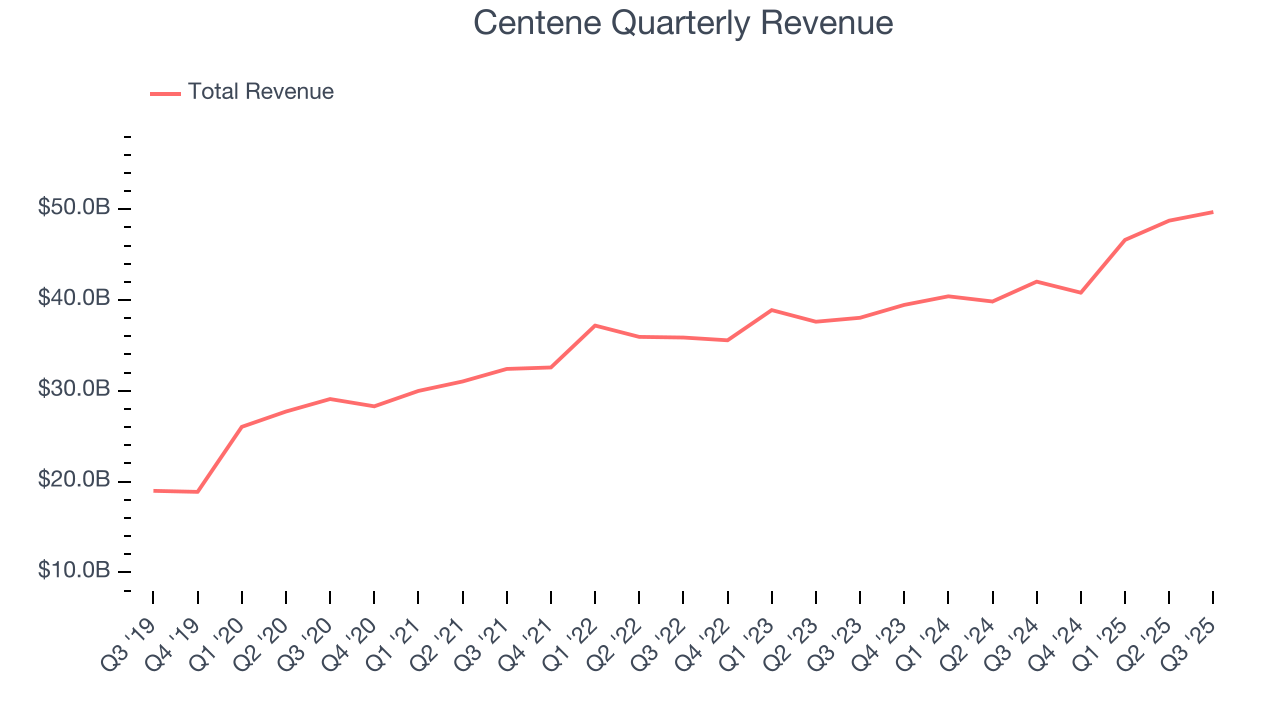
Long-term growth is the most important, but within healthcare, a half-decade historical view may miss new innovations or demand cycles. Centene’s annualized revenue growth of 11.3% over the last two years is below its five-year trend, but we still think the results were respectable. 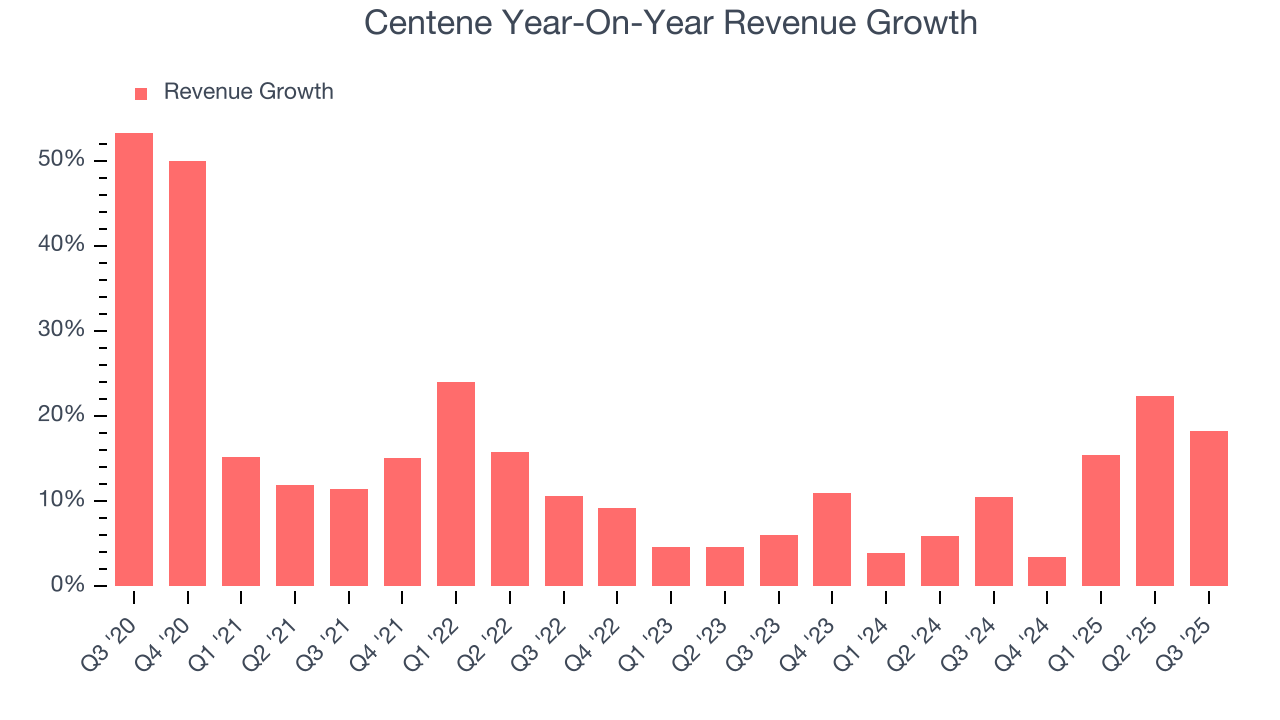
We can better understand the company’s revenue dynamics by analyzing its number of customers, which reached 27.97 million in the latest quarter. Over the last two years, Centene neither added nor lost customers. Because this number is lower than its revenue growth, we can see the average customer spent more money each year on the company’s products and services. 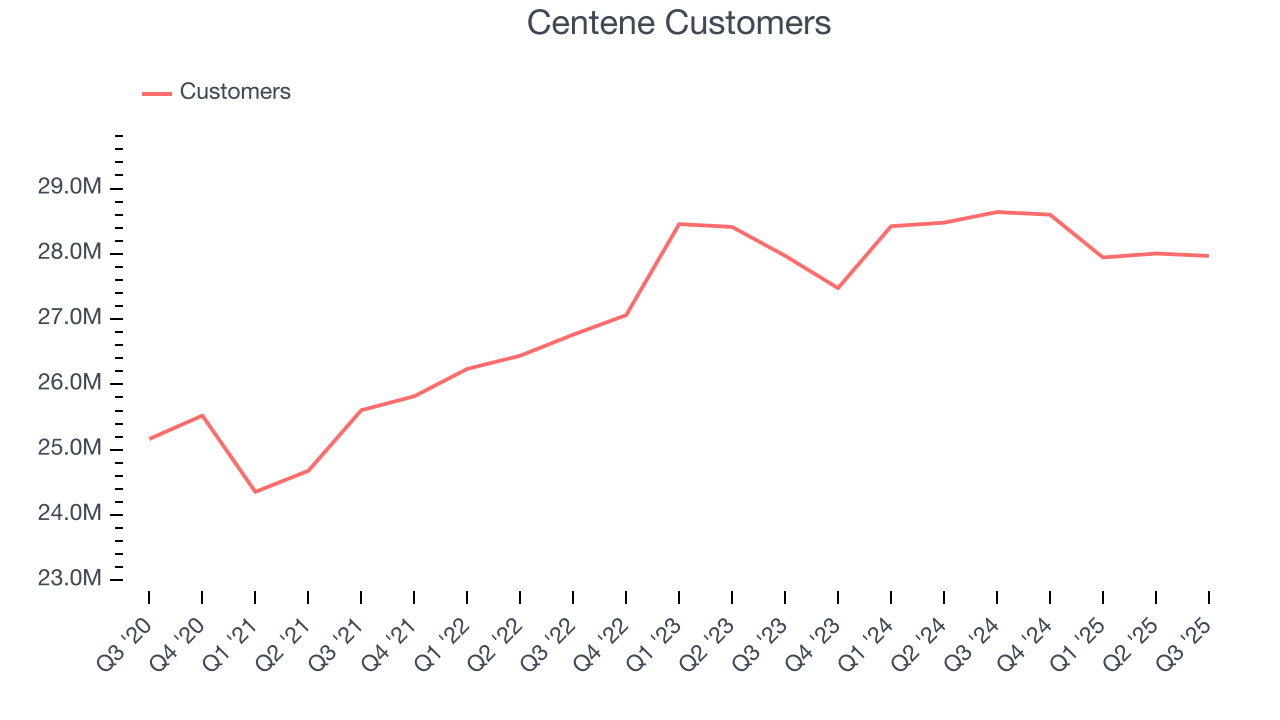
This quarter, Centene reported year-on-year revenue growth of 18.2%, and its $49.69 billion of revenue exceeded Wall Street’s estimates by 3.7%.
Looking ahead, sell-side analysts expect revenue to grow 2.6% over the next 12 months, a deceleration versus the last two years. This projection is underwhelming and indicates its products and services will see some demand headwinds. At least the company is tracking well in other measures of financial health.
7. Operating Margin
Centene was roughly breakeven when averaging the last five years of quarterly operating profits, lousy for a healthcare business.
Analyzing the trend in its profitability, Centene’s operating margin decreased by 4.1 percentage points over the last five years. The company’s two-year trajectory also shows it failed to get its profitability back to the peak as its margin fell by 5 percentage points. This performance was poor no matter how you look at it - it shows its expenses were rising and it couldn’t pass those costs onto its customers.
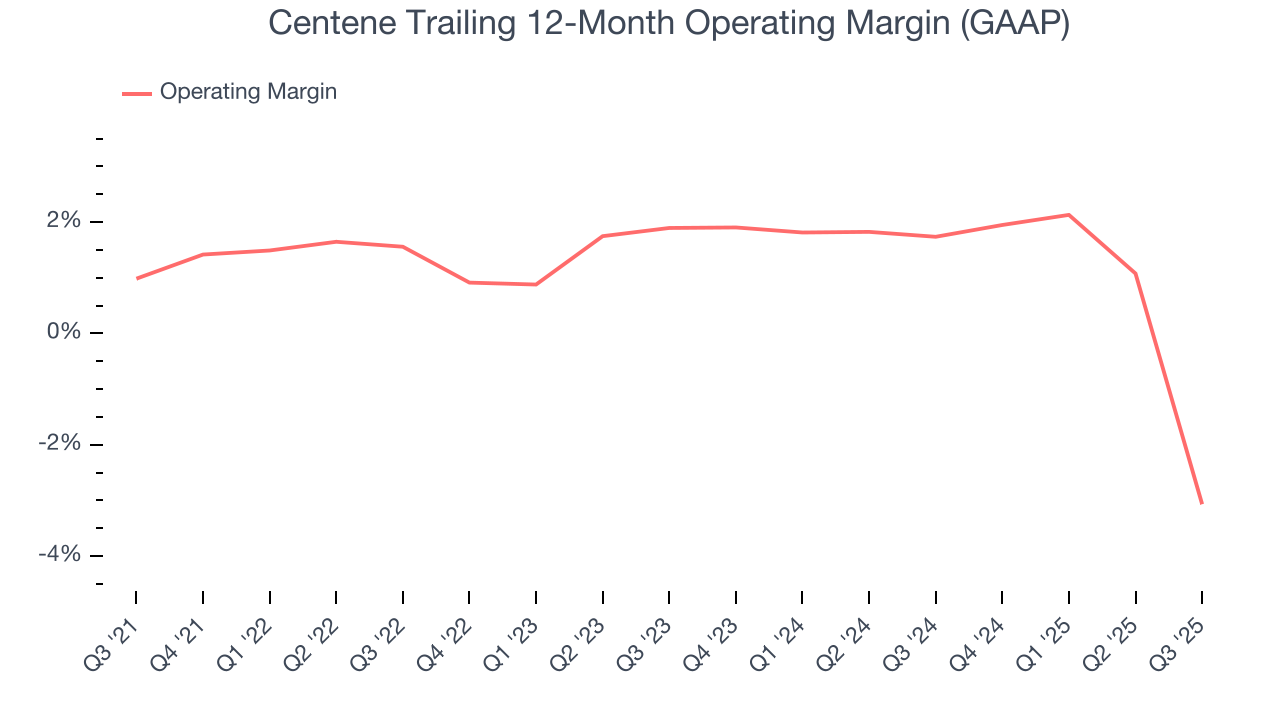
In Q3, Centene generated an operating margin profit margin of negative 14%, down 15.6 percentage points year on year due to a $6.7 billion non-cash goodwill impairment, resulting in a GAAP loss and corresponding reduction of retained earnings in the third quarter of 2025. This contraction shows it was less efficient because its expenses grew faster than its revenue.
8. Earnings Per Share
Revenue trends explain a company’s historical growth, but the long-term change in earnings per share (EPS) points to the profitability of that growth – for example, a company could inflate its sales through excessive spending on advertising and promotions.
Sadly for Centene, its EPS declined by 5.1% annually over the last five years while its revenue grew by 12.8%. This tells us the company became less profitable on a per-share basis as it expanded due to non-fundamental factors such as interest expenses and taxes.
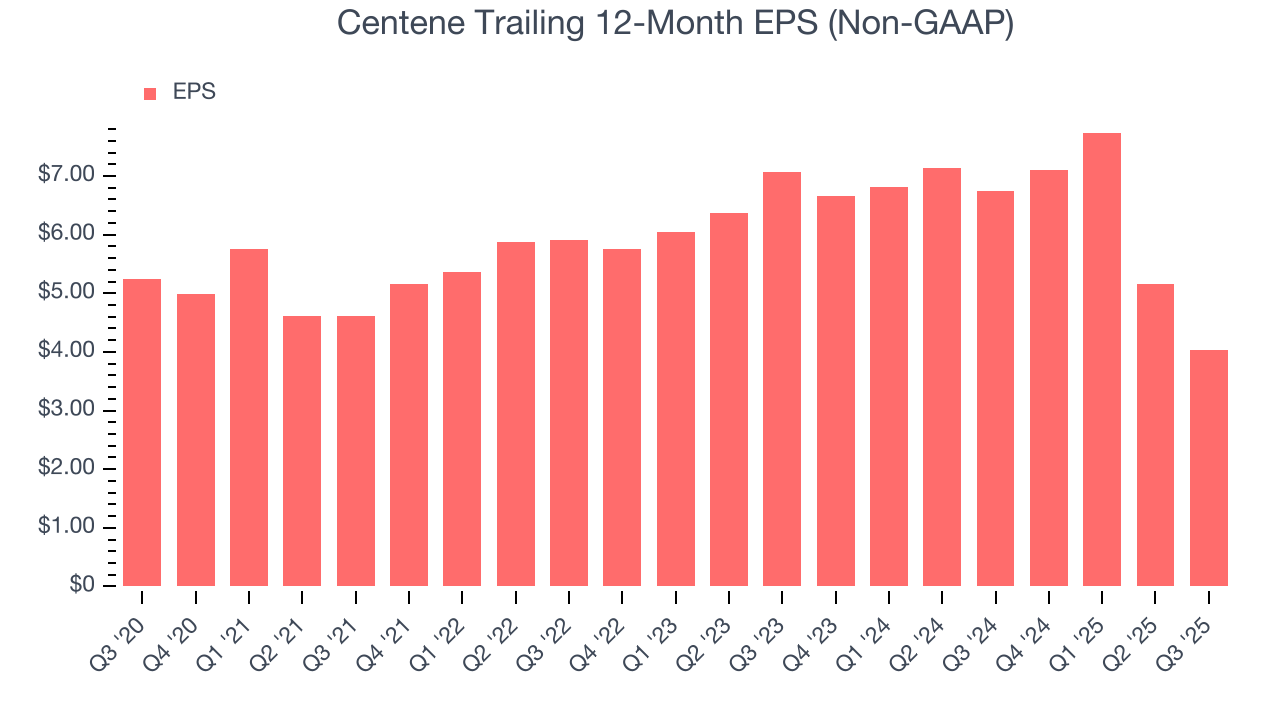
We can take a deeper look into Centene’s earnings to better understand the drivers of its performance. As we mentioned earlier, Centene’s operating margin declined by 4.1 percentage points over the last five years. This was the most relevant factor (aside from the revenue impact) behind its lower earnings; interest expenses and taxes can also affect EPS but don’t tell us as much about a company’s fundamentals.
In Q3, Centene reported adjusted EPS of $0.50, down from $1.62 in the same quarter last year. Despite falling year on year, this print easily cleared analysts’ estimates. Over the next 12 months, Wall Street expects Centene’s full-year EPS of $4.04 to shrink by 42.4%.
9. Cash Is King
Although earnings are undoubtedly valuable for assessing company performance, we believe cash is king because you can’t use accounting profits to pay the bills.
Centene has shown mediocre cash profitability over the last five years, giving the company limited opportunities to return capital to shareholders. Its free cash flow margin averaged 2.9%, subpar for a healthcare business.
Taking a step back, we can see that Centene’s margin dropped by 2.8 percentage points during that time. If the trend continues, it could signal it’s in the middle of an investment cycle.
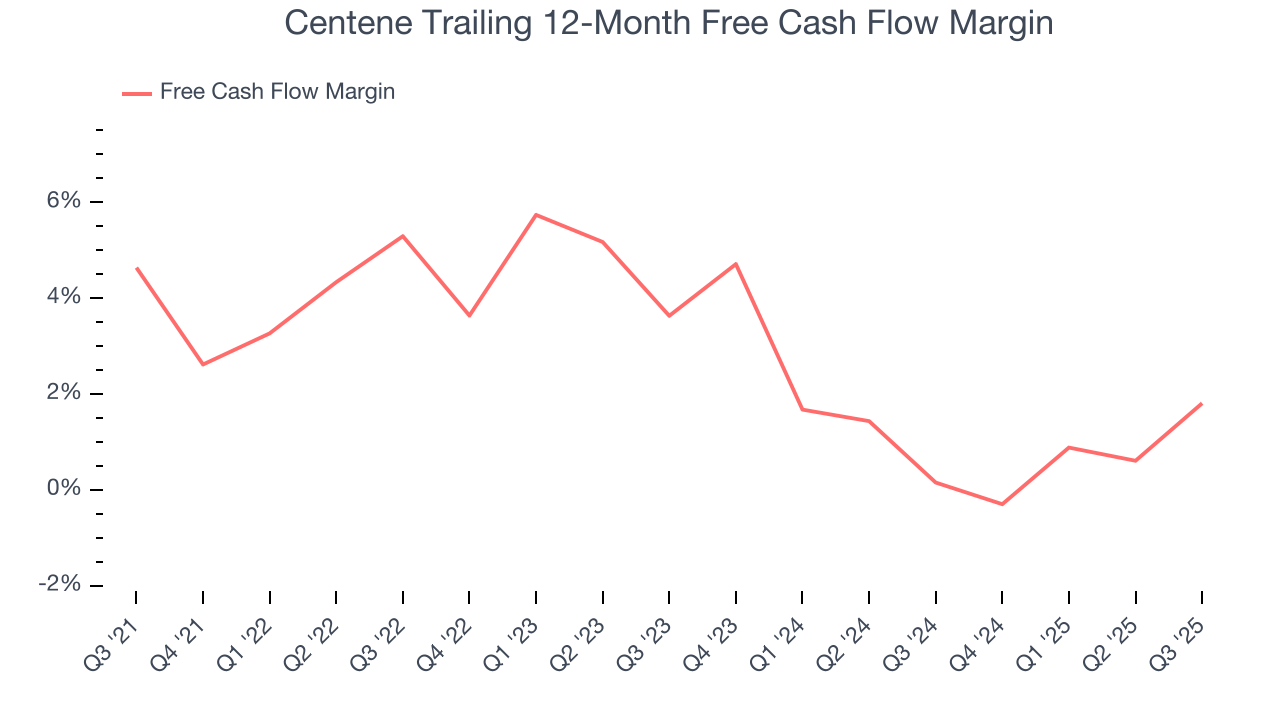
Centene’s free cash flow clocked in at $1.15 billion in Q3, equivalent to a 2.3% margin. Its cash flow turned positive after being negative in the same quarter last year. We hope the company can build on this trend.
10. Return on Invested Capital (ROIC)
EPS and free cash flow tell us whether a company was profitable while growing its revenue. But was it capital-efficient? Enter ROIC, a metric showing how much operating profit a company generates relative to the money it has raised (debt and equity).
Although Centene has shown solid business quality lately, it struggled to grow profitably in the past. Its five-year average ROIC was negative 1.4%, meaning management lost money while trying to expand the business.
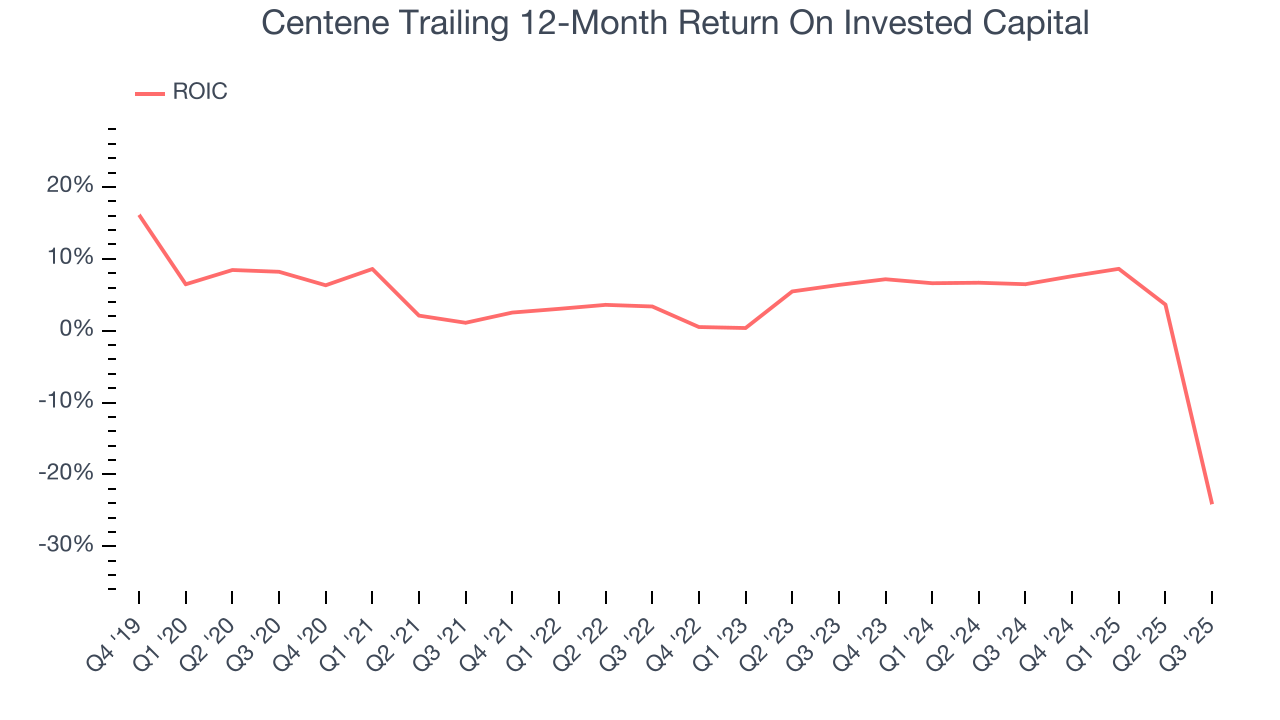
We like to invest in businesses with high returns, but the trend in a company’s ROIC is what often surprises the market and moves the stock price. Over the last few years, Centene’s ROIC has unfortunately decreased significantly. In the latest quarter, ROIC was hurt by a $6.7 billion non-cash goodwill impairment, resulting in a GAAP loss and corresponding reduction of retained earnings in the third quarter of 2025.
11. Balance Sheet Assessment
One of the best ways to mitigate bankruptcy risk is to hold more cash than debt.
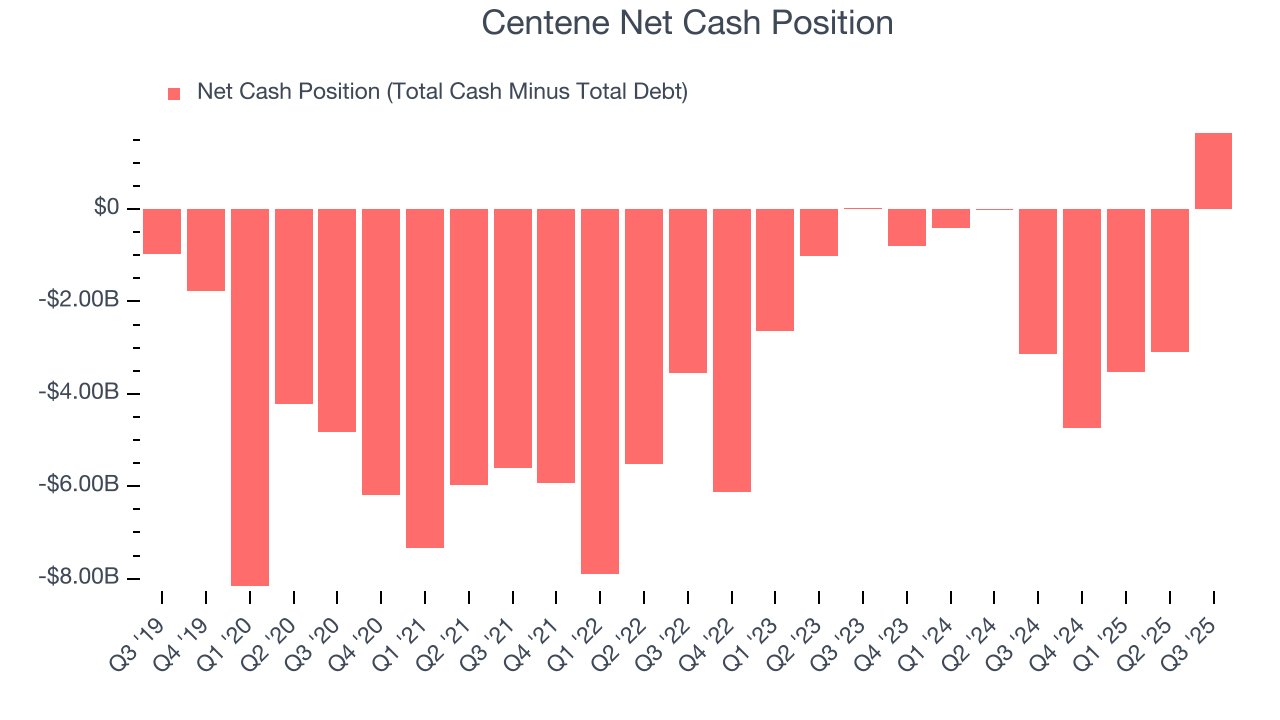
Centene is a well-capitalized company with $19.24 billion of cash and $17.58 billion of debt on its balance sheet. This $1.65 billion net cash position is 10.1% of its market cap and gives it the freedom to borrow money, return capital to shareholders, or invest in growth initiatives. Leverage is not an issue here.
12. Key Takeaways from Centene’s Q3 Results
It was good to see Centene beat analysts’ revenue and EPS expectations this quarter. We were also excited its full-year EPS guidance outperformed Wall Street’s estimates by a wide margin. Zooming out, we think this quarter featured some important positives. The stock traded up 10.8% to $36.77 immediately after reporting.
13. Is Now The Time To Buy Centene?
Updated: December 6, 2025 at 11:12 PM EST
Before making an investment decision, investors should account for Centene’s business fundamentals and valuation in addition to what happened in the latest quarter.
Centene isn’t a terrible business, but it doesn’t pass our quality test. Although its revenue growth was solid over the last five years, it’s expected to deteriorate over the next 12 months and its declining EPS over the last five years makes it a less attractive asset to the public markets. And while the company’s scale gives it meaningful leverage when negotiating reimbursement rates, the downside is its diminishing returns show management's prior bets haven't worked out.
Centene’s P/E ratio based on the next 12 months is 16x. While this valuation is fair, the upside isn’t great compared to the potential downside. We're fairly confident there are better stocks to buy right now.
Wall Street analysts have a consensus one-year price target of $39.94 on the company (compared to the current share price of $38.27).




